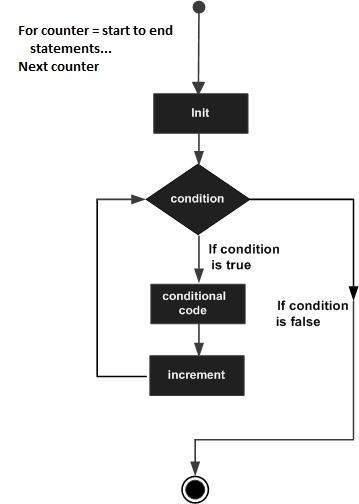
- VBA - Home
- VBA - Overview
- VBA - Excel Macros
- VBA - Excel Terms
- VBA - Macro Comments
- VBA - Message Box
- VBA - Input Box
- VBA - Variables
- VBA - Constants
- VBA - Operators
- VBA - Decisions
- VBA - Loops
- VBA - Strings
- VBA - Date and Time
- VBA - Arrays
- VBA - Functions
- VBA - Sub Procedure
- VBA - Events
- VBA - Error Handling
- VBA - Excel Objects
- VBA - Text Files
- VBA - Programming Charts
- VBA - Userforms
VB.Net - For...Next Loop
It repeats a group of statements a specified number of times and a loop index counts the number of loop iterations as the loop executes.
The syntax for this loop construct is:
For counter [ As datatype ] = start To end [ Step step ]
[ statements ]
[ Continue For ]
[ statements ]
[ Exit For ]
[ statements ]
Next [ counter ]
Flow Diagram:

Example
Module loops
Sub Main()
Dim a As Byte
' for loop execution
For a = 10 To 20
Console.WriteLine("value of a: {0}", a)
Next
Console.ReadLine()
End Sub
End Module
When the above code is compiled and executed, it produces the following result:
value of a: 10 value of a: 11 value of a: 12 value of a: 13 value of a: 14 value of a: 15 value of a: 16 value of a: 17 value of a: 18 value of a: 19 value of a: 20
If you want to use a step size of 2, for example, you need to display only even numbers, between 10 and 20:
Module loops
Sub Main()
Dim a As Byte
' for loop execution
For a = 10 To 20 Step 2
Console.WriteLine("value of a: {0}", a)
Next
Console.ReadLine()
End Sub
End Module
When the above code is compiled and executed, it produces the following result:
value of a: 10 value of a: 12 value of a: 14 value of a: 16 value of a: 18 value of a: 20
vb.net_loops.htm
Advertisements
